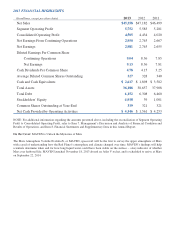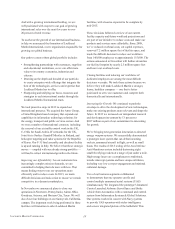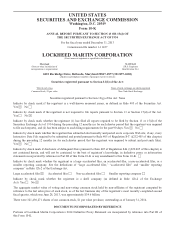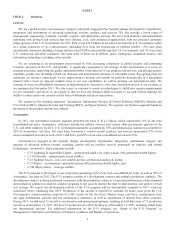Lockheed Martin 2013 Annual Report Download - page 12
Download and view the complete annual report
Please find page 12 of the 2013 Lockheed Martin annual report below. You can navigate through the pages in the report by either clicking on the pages listed below, or by using the keyword search tool below to find specific information within the annual report.Aeronautics produces and provides support and sustainment services for the C-130J Super Hercules, as well as upgrades
and support services for the legacy C-130 Hercules worldwide fleet. We delivered 25 C-130J aircraft in 2013, including six
to international customers, and our backlog extends through the middle of 2015. We currently have advanced funding from
the U.S. Government for additional C-130J aircraft not currently in backlog.
Aeronautics currently produces F-16 aircraft for international customers. Aeronautics also provides service-life extension,
modernization, and other upgrade programs for our customers’ F-16 aircraft. We delivered 13 F-16 aircraft in 2013, and our
backlog extends through the middle of 2017.
While production and deliveries of F-22 aircraft were completed in 2012, Aeronautics continues to provide
modernization and sustainment activities for the U.S. Air Force’s F-22 aircraft fleet. The modernization program comprises
upgrading existing systems requirements, developing new systems requirements, and adding capabilities and enhancing the
performance of the weapon systems. The sustainment program consists of sustaining the weapon systems of the F-22 fleet,
providing training systems, customer support, integrated support planning, supply chain management, aircraft modifications
and heavy maintenance, systems engineering, and support products.
Aeronautics provides sustainment services for the existing U.S. Air Force C-5 Galaxy fleet and modernization activities
to convert 49 C-5 Galaxy aircraft to the C-5M Super Galaxy configuration. These modernization activities include the
installation of new engines, landing gear and systems, and other improvements that will enable a shorter takeoff, a higher
climb rate, an increased cargo load, and longer flight range. As of December 31, 2013, we had delivered 13 C-5M aircraft
under these modernization activities, including six C-5M aircraft delivered in 2013.
In addition to the above aircraft programs, Aeronautics is involved in advanced development programs incorporating
innovative design and rapid prototype applications. Our Advanced Development Programs (ADP) organization, also known
as Skunk Works®, is focused on future systems, including unmanned aerial systems and next generation capabilities for
advanced strike, intelligence, surveillance, reconnaissance, situational awareness, and air mobility. We continue to explore
technology advancement and insertion in our existing aircraft. We also are involved in numerous network-enabled activities
that allow separate systems to work together to increase effectiveness, and continue to invest in new technologies to maintain
and enhance competitiveness in military aircraft design, development, and production.
Information Systems & Global Solutions
In 2013, our IS&GS business segment generated net sales of $8.4 billion, which represented 18% of our total
consolidated net sales. IS&GS’ customers include the various government agencies of the U.S. and other countries, military
services, as well as commercial and other customers. In 2013, U.S. Government customers accounted for 93%, international
customers accounted for 5%, and U.S. commercial and other customers accounted for 2% of IS&GS’ net sales. IS&GS has
been impacted by the continued downturn in federal information technology budgets.
IS&GS provides advanced technology systems and expertise, integrated information technology solutions, and
management services across a broad spectrum of applications for civil, defense, intelligence, and other government
customers. In addition, IS&GS supports the needs of customers in data analytics, cyber security, air traffic management, and
energy demand management. IS&GS provides network-enabled situational awareness, delivers communications and
command and control capability through complex mission solutions for defense applications, and integrates complex global
systems to help our customers gather, analyze, and securely distribute critical intelligence data. Also, IS&GS is responsible
for various classified systems and services in support of vital national security systems. While IS&GS has a portfolio of
many smaller contracts as compared to our other business segments, this business segment’s major programs include:
• The Hanford Mission Support contract, a program to provide infrastructure and site support services to the
Department of Energy.
• The Command, Control, Battle Management and Communications (C2BMC) contract, a program to increase the
integration of the Ballistic Missile Defense System for the U.S. Government.
• The En Route Automation Modernization (ERAM) contract, a program to replace the Federal Aviation
Administration’s infrastructure with a modern automation environment that includes new functions and
capabilities.
• The Defense Information Systems Agency (DISA) – Global Information Grid Services Management-Operations
contract, a program to provide operations and maintenance to the DoD’s global data network.
• The National Science Foundation’s U.S. Antarctic Support program, which manages sites and equipment to
enable universities, research institutions, and federal agencies to conduct scientific research in the Antarctic.
4
























